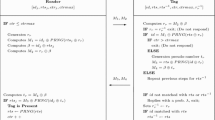Abstract
This paper introduces the Adopted-Pet (AP) protocol, an automatic (i.e. requiring no human interaction) secure pairing protocol, adequate for the pairing between a passive RFID tag and a reader. Most pairing protocols rely for their security on a certain advantage that the legitimate devices have over any malicious users. Such advantages include proximity (employing near-field communication) or secret keys that are either produced with the assistance of, or verified by, the legitimate user. The advantage exploited by our novel AP protocol is the amount of uninterrupted time spent by the two devices in the proximity (although not requiring near-field communication) of each-other. We discuss several implementation configurations, all based on pseudo-random bit generators, employing short-length LFSRs, and requiring no more than 2000 transistors. This makes the protocol ideally suited for low-cost passive RFID tags. For each configuration we show that the AP protocol is highly secure against occasional malicious entities.
Access this chapter
Tax calculation will be finalised at checkout
Purchases are for personal use only
Preview
Unable to display preview. Download preview PDF.
Similar content being viewed by others
References
Dobkin, D.M.: The RF in RFID: passive UHF RFID in Practice. Elsevier Inc. (2008)
Stajano, F., Anderson, R.: The resurrecting duckling: security issues for ad-hoc wireless networks. In: AT&T Software Symposium (1999)
Mayrhofer, R., Gellersen, H.: Shake Well Before Use: Authentication Based on Accelerometer Data. In: LaMarca, A., Langheinrich, M., Truong, K.N. (eds.) Pervasive 2007. LNCS, vol. 4480, pp. 144–161. Springer, Heidelberg (2007)
Oshiba, T., Nebayashi, H.: Device pairing based on adaptive channel fluctuation control for large-scale organizations. In: IEEE Symposium on Computers and Communications, ISCC 2009, pp. 901–906 (2009)
Soriente, C., Tsudik, G., Uzun, E.: BEDA: button-enabled device association. In: International Workshop on Security for Spontaneous Interaction, IWSSI 2007 (2007)
Luo, S., Xia, H., Gao, Y., Jin, J., Athauda, R.: Smart fridges with multimedia capability for better nutrition and health. In: International Symposium on Ubiquitous Multimedia Computing, UMC 2008, pp. 39–44 (2008)
Gu, H., Wang, D.: A content-aware fridge based on RFID in smart home for home-healthcare. In: 11th International Conference on Advanced Communication Technology, ICACT 2009, vol. 2, pp. 987–990 (2009)
Hopper, N.J., Blum, M.: Secure human identification protocols. In: Boyd, C. (ed.) ASIACRYPT 2001. LNCS, vol. 2248, pp. 52–66. Springer, Heidelberg (2001)
Massey, J.L.: Shift-register synthesis and BCH decoding. IEEE Trans. Information Theory 15, 122–127 (1969)
Juels, A.: Minimalist Cryptography for Low-Cost RFID Tags (Extended abstract). In: Blundo, C., Cimato, S. (eds.) SCN 2004. LNCS, vol. 3352, pp. 149–164. Springer, Heidelberg (2005)
Menezes, A., van Oorschot, P., Vanstone, S.: Handbook of Applied Cryptography. CRC Press (1996)
Cusick, T.V., Stanica, P.: Cryptographic Boolean Functions and Applications. Elsevier Inc. (2009)
Lhlein, B.: Attacks based on conditional correlations against the nonlinear filter generator. In: Cryptology ePrint Archive, Report 2003/020 (2003)
Golic, J.D., Clark, A., Dawson, E.: Generalized inversion attack on nonlinear filter generators. IEEE Trans. Computers 49, 1100–1109 (2000)
Golic, D.: On the security of nonlinear filter generators. In: Proc. Fast Software Encryption – Cambridge 1996, pp. 173–188 (1996)
Courtois, N.T., Meier, W.: Algebraic Attacks on Stream Ciphers with Linear Feedback. In: Biham, E. (ed.) EUROCRYPT 2003. LNCS, vol. 2656, pp. 345–359. Springer, Heidelberg (2003)
Siegenthaler, T.: Cryptanalysts Representation of Nonlinearly Filtered ML-Sequences. In: Pichler, F. (ed.) EUROCRYPT 1985. LNCS, vol. 219, pp. 103–110. Springer, Heidelberg (1986)
Coppersmith, D., Krawczyk, H., Mansour, Y.: The Shrinking Generator. In: Stinson, D.R. (ed.) CRYPTO 1993. LNCS, vol. 773, pp. 22–39. Springer, Heidelberg (1994)
Blackburn, S.R.: The complexity of the self-shrinking generator. IEEE Transactions on Information Theory 45, 2073–2077 (1999)
Fraenkel, A.S., Yesha, Y.: Complexity of problems in games, graphs and algebraic equations. Discrete Applied Mathematics 1, 15–30 (1979)
Courtois, N.T., Pieprzyk, J.: Cryptanalysis of Block Ciphers with Overdefined Systems of Equations. In: Zheng, Y. (ed.) ASIACRYPT 2002. LNCS, vol. 2501, pp. 267–287. Springer, Heidelberg (2002), Updated version: http://eprint.iacr.org/2002/044
Author information
Authors and Affiliations
Editor information
Editors and Affiliations
Rights and permissions
Copyright information
© 2012 Springer-Verlag Berlin Heidelberg
About this paper
Cite this paper
Amariucai, G.T., Bergman, C., Guan, Y. (2012). An Automatic, Time-Based, Secure Pairing Protocol for Passive RFID. In: Juels, A., Paar, C. (eds) RFID. Security and Privacy. RFIDSec 2011. Lecture Notes in Computer Science, vol 7055. Springer, Berlin, Heidelberg. https://doi.org/10.1007/978-3-642-25286-0_8
Download citation
DOI: https://doi.org/10.1007/978-3-642-25286-0_8
Publisher Name: Springer, Berlin, Heidelberg
Print ISBN: 978-3-642-25285-3
Online ISBN: 978-3-642-25286-0
eBook Packages: Computer ScienceComputer Science (R0)




